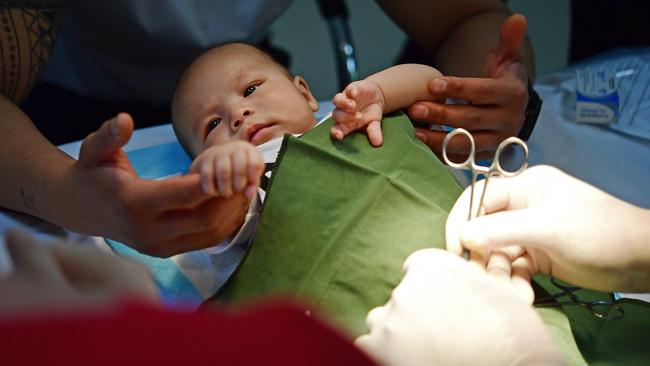Male circumcision is a common procedure that has been performed for thousands of years. It involves the removal of the foreskin from the penis, and it’s often done for medical, cultural, or religious reasons. One of the most frequently asked questions surrounding male circumcision is whether it is painful for babies. In this article, we will explore the pain associated with the procedure, the techniques used by doctors to minimize discomfort, and the benefits of Male Circumcision in Dubai. Additionally, we will discuss what parents can expect from the procedure and how doctors ensure that the experience is as comfortable as possible for the infant.
Male Circumcision Treatment Process and Pain Management
Male circumcision is typically performed on babies within the first few weeks of life, though it can also be done later in childhood or adulthood. The procedure itself is quick, lasting about 10 to 30 minutes. To ensure that the baby experiences minimal discomfort, doctors use various techniques for pain management. These methods include local anesthesia, which numbs the area, and sometimes, sedation to keep the baby calm and still.
In most cases, doctors will administer a local anesthetic, such as a topical cream or injection, before performing the circumcision. The local anesthesia works by numbing the area, allowing the procedure to be completed without causing significant pain. While the injection itself might cause a brief moment of discomfort, the baby will not experience ongoing pain during the circumcision.
Doctors are highly trained to perform circumcisions efficiently, using techniques that minimize discomfort. In some cases, a special clamp or other medical device is used to reduce the duration of the procedure and the pressure applied to the penis. These devices are designed to make the process as smooth and swift as possible while ensuring the safety and well-being of the baby.
Benefits of Male Circumcision for Babies
While the decision to circumcise a baby can be influenced by cultural or religious beliefs, there are several health benefits associated with the procedure. Circumcision has been linked to a lower risk of urinary tract infections (UTIs) during infancy, which can be uncomfortable and potentially lead to more serious health issues. Circumcision also reduces the risk of developing certain sexually transmitted infections (STIs) later in life, including HIV.
In addition to the health benefits, circumcision can improve hygiene by making it easier to clean the area. The removal of the foreskin eliminates the space where bacteria and debris can accumulate, reducing the risk of infections. Many parents find that circumcising their child early on helps to prevent these health issues later in life.
Doctor's Role in Male Circumcision Treatment
A doctor’s primary concern during male circumcision is to ensure that the baby experiences minimal pain and discomfort while undergoing the procedure. To achieve this, doctors use proven pain management techniques, including local anesthesia and sometimes sedation. These treatments are specifically chosen to address the needs of newborns, who may be more sensitive to pain than older children or adults.
Doctors are also responsible for making sure that the circumcision is performed safely and effectively. This involves using sterile instruments and maintaining a clean environment to reduce the risk of infection. Additionally, the doctor will monitor the baby’s vitals throughout the procedure to ensure that they are in a stable condition.
After the circumcision is completed, the doctor will provide parents with detailed aftercare instructions. This is crucial for the baby’s healing process, as the doctor will guide parents on how to care for the wound, what signs to watch for, and when to seek medical attention if necessary.
Common Concerns and FAQs About Male Circumcision for Babies
1. Is male circumcision painful for babies?
While male circumcision can cause some discomfort, doctors use effective pain management techniques, such as local anesthesia and sedation, to minimize pain. Most babies do not experience prolonged pain during or after the procedure.
2. How long does a male circumcision procedure take?
The circumcision procedure usually takes about 10 to 30 minutes. It is a relatively quick and efficient process performed by trained medical professionals to ensure the baby’s safety and comfort.
3. What type of anesthesia is used for male circumcision in babies?
Doctors typically use local anesthesia to numb the area before performing the circumcision. This ensures that the baby does not feel pain during the procedure. In some cases, sedation may also be used to keep the baby calm.
4. Can I breastfeed my baby after circumcision?
Yes, breastfeeding is generally recommended after circumcision. It can help soothe the baby and provide comfort while also promoting healing.
5. How should I care for my baby after circumcision?
After the procedure, doctors will provide specific aftercare instructions. This may include keeping the area clean, applying ointments, and watching for signs of infection. It’s essential to follow these instructions closely to ensure proper healing.
Conclusion
Male circumcision is a safe and well-established procedure that can offer numerous health benefits for babies. While it may cause some brief discomfort, the use of local anesthesia and other pain management techniques ensures that the baby experiences minimal pain during the procedure. Doctors are highly skilled in performing circumcisions, prioritizing the comfort and well-being of the infant. For parents considering male circumcision for their baby, it’s important to consult with a qualified medical professional to understand the procedure and its benefits fully. If you are in Dubai, many reputable clinics, like Dynamic Clinic, offer expert male circumcision services that prioritize both comfort and safety.





Comments